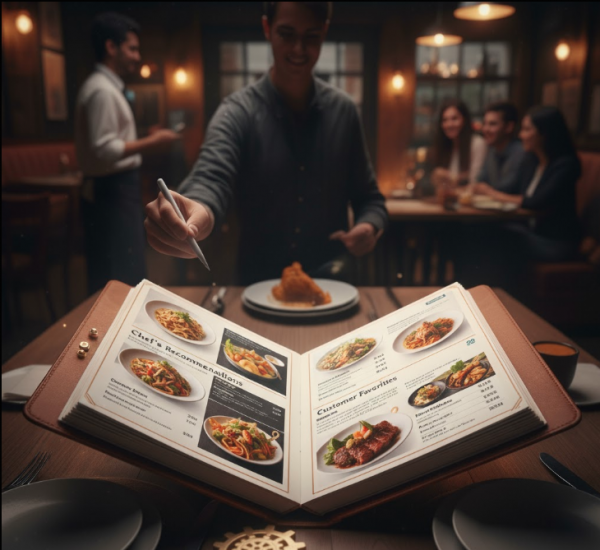Every restaurant owner knows the frustration of watching potential revenue slip through their fingers. Maybe it’s a bestselling dish that doesn’t bring in enough profit, or a menu priced too high that drives customers to competitors.
Poor pricing decisions can quietly erode your bottom line and make it difficult for your restaurant to reach its full revenue potential.
Setting the right price is a strategic decision that directly determines your restaurant’s profitability. It transforms your menu from a simple list of dishes into a profit-generating instrument.
In this guide, we’ll break down actionable strategies for pricing your menu to drive profits, including popular methods and proven tactics that turn every menu item into a revenue booster.
Popular Restaurant Pricing Methods You Can Use
Selecting the right pricing method lays the foundation for sustainable growth. Here are the most trusted restaurant pricing methods used by successful operators:
1. Cost-Plus (Mark-Up) Pricing
This method adds a fixed percentage of profit to your total cost. It is simple and guarantees that all expenses are covered.
Formula:
Menu Price = (Total Cost per Dish) + (Desired Profit Margin)
For instance, if your pasta dish costs $8 and you want a 35% margin, your selling price would be around $12.30.
The strength of cost-plus pricing lies in its predictability. However, it may overlook market competition or perceived value, so it works best for dishes with consistent and stable costs.
2. Value-Based Pricing
Value-based pricing revolves around what your customers are willing to pay rather than your cost structure. It considers perceived value and brand positioning. Fine dining restaurants often use this approach by emphasizing presentation and ambiance.
For example, a steak priced at $40 in a premium restaurant might seem reasonable because the customer values the dining experience beyond the food itself. This approach deepens loyalty and enhances brand prestige.
3. Competitive Pricing
This method benchmarks your prices against competitors offering similar products. You can price slightly lower than competitors to attract more customers or slightly higher to project superior quality. But this pricing method requires constant market tracking.
4. Dynamic or Demand-Based Pricing
Dynamic pricing adjusts menu prices based on timing or demand. For example, offering early bird discounts or premium weekend pricing can balance revenue across peak and off-peak periods.
This model, supported by technology, allows restaurants to stay agile and maximize profits while meeting customer expectations.
5. Psychological Pricing Techniques
Psychology plays a vital role in menu perception. Small details can drive big decisions. Here are some proven techniques:
– Charm Pricing
Set prices like $9.99 instead of $10 to create a perception of better value.
– Anchor Pricing
Place a higher-priced dish next to a moderately priced one to make the latter appear more affordable.
– Currency-Free Menus
Omitting currency symbols reduces the focus on spending and encourages diners to order more.
– Menu Positioning
Place high-margin items in visual hotspots, like the top left, middle, and bottom right sections of the menu, to boost sales.
7 Proven Menu Pricing Strategies for Higher Profits
Once your pricing methods are in place, the next step is implementation. Here are seven actionable menu pricing strategies designed to increase profitability.
1. Pick The Right Menu Model for Your Operation
Every restaurant has its own identity, and your menu should reflect that. For example, you might offer:
- A limited menu with a few carefully curated dishes.
- A seasonal menu that changes with available ingredients.
- A prix fixe menu with set courses.
- A promotion-based menu featuring special offers and combos.
For casual dining, an easy-to-scan layout with clear combos works best. For fine dining, a minimalist menu highlighting premium ingredients can elevate perceived value.
With a well-structured menu pricing format, you not only guide customers to the right selections but also make the ordering experience more enjoyable for them.
2. Apply Menu Design Psychology
Strategic menu design can influence purchase behavior. Therefore, use visual hierarchy, white space, and engaging descriptions to highlight profitable items.
For example, replace dull descriptions like “Grilled Chicken Sandwich” with sensory phrases such as “Fire-Grilled Chicken Sandwich with Herb Aioli.” This emotional connection justifies higher prices and enhances customer experience.
3. Bundle and Combo Offers
Combining multiple items into one value deal can increase both order volume and perceived value. For example, a burger, fries, and drink combo priced slightly lower than the sum of individual items encourages customers to spend more overall.
This approach also improves kitchen efficiency, as bundled meals streamline preparation. Quick-service restaurants rely on this strategy to maximize average order value without raising prices dramatically.
4. Experiment with Limited-Time or Experiential Offers
Exclusive menu items or limited-time offers create urgency and excitement. They encourage repeat visits and can justify premium pricing. You can tie them to seasons, local events, or special collaborations.
For instance, offering a “Summer Chef’s Special” or a “Weekend Tasting Experience” adds novelty and helps you gauge customer preferences before introducing permanent menu items.
5. Highlight High-Margin Items
Not all dishes contribute equally to profits. Use sales data to identify high-margin items and feature them prominently. Label them as “Chef’s Recommendation” or “Customer Favorite.”
Highlighting these items through visuals or placement within the golden triangle or other prominent shapes increases their visibility and appeal.
6. Introduce Tiered Pricing Options
A tiered pricing model allows you to cater to different spending levels. It also gives diners a sense of control while gently encouraging them toward higher-value purchases.
Offer “good,” “better,” and “best” options for popular dishes. For example:
- Basic burger: $8
- Premium burger with toppings: $12
- Deluxe burger combo with fries and drink: $15
7. Upselling and Cross-Selling
Lastly, encourage your staff to recommend complementary items naturally. For example, suggest a side salad with pasta, a dessert with coffee, or upgrading a small coffee to a large. These small suggestions can increase the total bill without extra marketing costs.
Maximize Restaurant Revenue Using Mapchise Pricing Intelligence
In a competitive, data-driven market, pricing based on the guesswork of ‘how to price a menu item’ is no longer enough. Restaurants need real-time insights to make smarter, faster decisions and that is exactly what Mapchise delivers.
Mapchise is a restaurant-exclusive platform that merges AI analytics, location intelligence, and competitor tracking to optimize pricing across every location. It helps identify the most profitable menu items and fine-tune prices with precision.
By replacing guesswork with real intelligence, Mapchise transforms pricing into a powerful growth strategy that boosts revenue and strengthens every expansion decision.
Conclusion
Ultimately, the recipe for restaurant success goes beyond delicious dishes. It lies in pricing with purpose. A well-crafted pricing strategy built on customer psychology and modern tools can transform how your restaurant earns.
When you apply smart approaches like value-based pricing, menu design psychology, and bundled offers, you are actively shaping profitability for your restaurant.
With Mapchise, that process becomes simpler and sharper. Its intelligent insights help restaurants make data-backed decisions that turn pricing into long-term profit.
Thriving restaurants in competitive markets know that success comes from pricing smartly, not simply raising prices.


